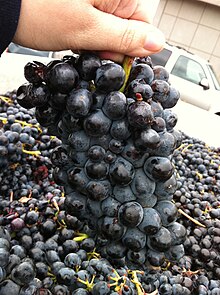| Barbera | |
|---|---|
| Grape (Vitis) | |
 Cluster of Barbera grapes | |
| Color of berry skin | Noir |
| Species | Vitis vinifera |
| Also called | (more) |
| Origin | Italy |
| Notable regions | Montferrat (Italy), California, Australia and Argentina |
| Notable wines | Nizza, Barbera d'Asti |
| VIVC number | 974 |
Barbera is a red Italian wine grape variety that, as of 2000, was the third most-planted red grape variety in Italy (after Sangiovese and Montepulciano). It produces good yields and is known for deep color, full body, low tannins and high levels of acidity.[1]
Century-old vines still exist in many regional vineyards and allow for the production of long-aging, robust red wines with intense fruit and enhanced tannic content. The best-known appellation is the DOCG (Denominazione di Origine Controllata e Garantita) Barbera d'Asti in the Piedmont region: the highest-quality Nizza DOCG wines are produced within a sub-zone of the Barbera d'Asti production area.[2] When young, the wines offer a very intense aroma of fresh red cherries and blackberries. In the lightest versions notes of cherries, raspberries and blueberries and with notes of blackberry and black cherries in wines made of more ripe grapes. Many producers employ the use of toasted oak barrels, which provides for increased complexity, aging potential, and hints of vanilla notes. The lightest versions are generally known for flavors and aromas of fresh fruit and dried fruits, and are not recommended for cellaring. Wines with a better balance between acid and fruit, often with the addition of oak and having a high alcohol content are more capable of cellaring; these wines often result from reduced-yield viticultural methods.[3]
- ^ J. Robinson (ed) The Oxford Companion to Wine Third Edition pg 62-63 Oxford University Press 2006 ISBN 0-19-860990-6
- ^ "Wine Varietals Guide - Types of Grapes | Wine of the Month Club". The International Wine of the Month Club. Retrieved 2018-06-29.
- ^ Robinson, Jancis Vines, Grapes & Wines pg 145-147 Mitchell Beazley 1986 ISBN 1-85732-999-6